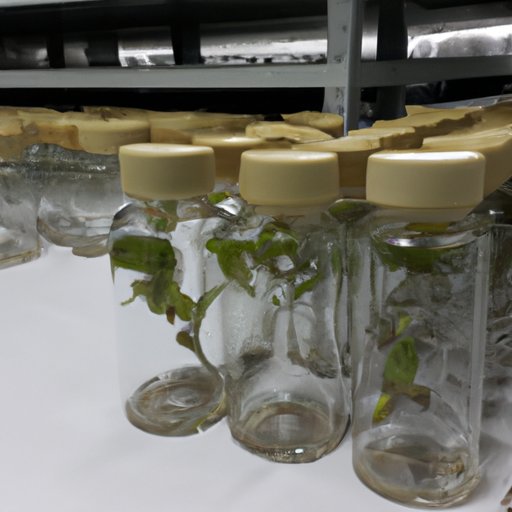Introduction
Tissue culture plants, also known as micropropagated plants, are plants that have been grown in a laboratory from a small piece of tissue or cell. This type of plant propagation is used to produce large numbers of genetically identical plants from a single source, resulting in plants that are true-to-type and free of diseases. The process is relatively simple and can be used to produce high-quality plants quickly and cost-effectively.

Exploring the Basics of Tissue Culture Plants
The term “tissue culture” refers to the process of growing cells, tissues, or organs in an artificial medium outside of their natural environment. In plant tissue culture, a small piece of plant material, such as a leaf, stem, or root, is placed in a sterile container with a nutrient solution. The cells of the plant then divide and multiply, producing a cluster of new plants known as “plantlets”. These plantlets are then transferred to a soil-based medium where they can continue to grow and develop into mature plants.
Tissue culture offers several advantages over traditional methods of plant propagation. It is a fast and efficient way to produce large numbers of plants with minimal effort. The plants produced through tissue culture are genetically identical, meaning they will all have the same characteristics as the parent plant. This makes it ideal for producing plants with desirable traits, such as disease resistance or improved yield. Additionally, because the plants are grown in a sterile environment, they are free from disease and pests.
A Comprehensive Guide to Tissue Culture Plants
Tissue culture is a complex process and requires specialized knowledge and equipment. To get started, you will need a sterile work area, appropriate containers, growth media, and plant material. You will also need to know how to properly prepare the plant material, set up the equipment, culture the plants, and harvest the plantlets.
Step-By-Step Instructions
Before beginning the tissue culture process, it is important to thoroughly clean and sterilize all equipment and surfaces. Once everything is ready, the next step is to prepare the plant material. This involves selecting healthy, disease-free material and cutting it into small pieces. The pieces should be placed in a sterile container filled with a nutrient-rich growth medium.
Once the plant material has been placed in the container, the container should be sealed and placed in an incubator to provide the optimal temperature and light conditions. After a few days, the plantlets will begin to form. At this point, they should be transferred to a new container and provided with more nutrients. This process should be repeated until the plantlets are large enough to be harvested.
What You Need to Know
When growing tissue culture plants, it is important to monitor the nutrient levels in the medium and adjust as needed. The pH level should also be monitored and kept within the optimal range for the particular species of plant being cultured. Additionally, it is important to keep the containers clean and free from contaminants such as bacteria and fungi.
Different Types of Tissue Culture Plants
Tissue culture can be used to propagate a wide range of plants, including trees, shrubs, flowers, vegetables, and even some aquatic plants. Some plants are more difficult to propagate than others, but with the right techniques and materials, most plants can be successfully cultured.
Growing Tissue Culture Plants
Once the plantlets have been harvested, they must be hardened off before they can be transplanted into soil. Hardening off involves gradually exposing the plantlets to outdoor conditions, such as sunlight and wind, over a period of several weeks. This helps to acclimate the plantlets to their new environment and reduces the risk of shock or death.
Once the plantlets have been hardened off, they can be transplanted into soil. It is important to use a well-draining soil mixture and to water the plants regularly. With proper care, the plants should continue to grow and thrive.
Conclusion
Tissue culture plants offer many advantages over traditional methods of plant propagation. They are fast, efficient, and produce high-quality plants that are true-to-type and free from diseases. They are also a cost-effective way to produce large numbers of genetically identical plants. With the right knowledge and equipment, anyone can learn to grow tissue culture plants.
By following the steps outlined above, you can easily get started with tissue culture plants. Remember to take your time and be patient, as it may take several weeks or months for the plants to reach maturity. With a bit of practice, you will soon be able to produce healthy, high-quality plants.
Summary of Benefits
- Produce large numbers of plants quickly and cost-effectively
- Produce genetically identical plants that are true-to-type and free from diseases
- Produce plants with desirable traits, such as disease resistance or improved yield
- Easy to learn and requires minimal effort

Final Thoughts on Tissue Culture Plants
Tissue culture plants are an efficient and cost-effective way to produce large numbers of genetically identical plants. With the right knowledge and equipment, anyone can learn to grow tissue culture plants. Just remember to be patient and take your time, as it may take several weeks or months for the plants to reach maturity.
“Tissue culture technology has revolutionized agriculture and horticulture,” says Dr. John Hammond, professor of plant science at the University of California, Davis. “It provides a reliable, cost-effective way to produce high-quality plants quickly and efficiently.
(Note: Is this article not meeting your expectations? Do you have knowledge or insights to share? Unlock new opportunities and expand your reach by joining our authors team. Click Registration to join us and share your expertise with our readers.)
